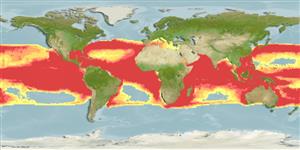Classification / Names
Common names from other countries
Main reference
Size / Weight / Age
Max length : 488 cm TL male/unsexed; (Ref. 40637); common length : 350 cm TL male/unsexed; (Ref. 5217); max. published weight: 363.8 kg (Ref. 40637); max. reported age: 20 years (Ref. 28081)
Length at first maturity
Lm ?, range 154 - 341 cm
Environment
Marine; pelagic-oceanic; oceanodromous (Ref. 51243); depth range 0 - 730 m (Ref. 89423), usually 0 - 100 m (Ref. 43278)
Climate / Range
Subtropical, preferred 27°C (Ref. 107945); 46°N - 40°S, 180°W - 180°E (Ref. 54278)
Distribution
Short description
Dorsal
spines
(total): 0;
Dorsal
soft rays
(total): 0;
Anal
spines: 0;
Anal
soft rays: 0. A large thresher with very large eyes, an indented forehead, a broad caudal tip, and curved broad-tipped pectoral fins; 1st dorsal fin further back than in other threshers (Ref. 5578). Upper lobe of caudal fin very long and strap-like almost or quite equal to length of rest of shark; lower lobe short but well developed (Ref. 13570). Purplish grey above, cream below, posterior edges of pectoral and pelvic fins and sometimes first dorsal fin dusky; light color of abdomen not expanded over pectoral-fin bases (Ref. 13570).
IUCN Red List Status (Ref. 115185)
Human uses
Fisheries: commercial; gamefish: yes
More information
ReferencesAquacultureAquaculture profileStrainsGeneticsAllele frequenciesHeritabilityDiseasesProcessingMass conversion
Tools
Special reports
Download XML
Internet sources
Estimates of some properties based on models
Phylogenetic diversity index
PD50 = 0.7500 many relatives (e.g. carps) 0.5 - 2.0 few relatives (e.g. lungfishes)
Trophic Level
4.5 ±0.0 se; Based on diet studies.
Resilience
Low, minimum population doubling time 4.5 - 14 years (tm=7; K=0.088; Fec=2-4)
Vulnerability
Very high vulnerability (79 of 100)
Price category
